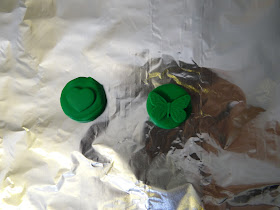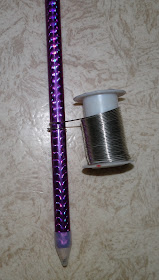Thursday, April 28, 2016
Nebula in a Bottle/Magical Potion Vial
Here is a multipurpose craft. I made it to be a nebula in a bottle, but when I was done I realized it could also make for a neat "magical" potion. Although Halloween is still months away, if you're looking for some not so creepy decor ideas, you may want to keep this craft in mind.
Materials:
*Vial or bottle with a cork
*Food coloring in color of your choice
*Water
*Silver glitter
*Cotton (I used stuffing because that was what I had on hand, but if you want more of a color contrast like some of the other nebula in a bottle crafts have, you'll want to use cotton).
Directions:
*Add a few drops of food coloring to some water, until you reach your desired color.
*Using a measuring cup or some other instrument that will allow you to pour liquid in a little at a time, add some of the colored water to the bottle/vial.
*Add some cotton and then pack it down. If you pack it very densely, more of the white will show through, whereas if you go for a looser packing, you won't see as much of a color gradient.
*Add some glitter and mix it around inside the bottle. I was using a very small vial, so I used the long straight end of a mixer blade for mixing purposes.
*Add more colored water.
*Add more cotton, followed by more glitter, and then mix. Fill up any remaining space with colored water. Put the cork back on and now you're done!
*Note: I've read that if you add clear nail polish to the bottom/sides of the cork you can prevent the dye from seeping through the cork. I didn't have any clear nail polish on hand, so I couldn't try it myself, but I figured I'd throw the idea out there in case any of you were interested.
Thursday, April 21, 2016
Clay and Wine Cork Stamp
There are tons of neat crafts out there for using wine corks, but many of these require stockpiling large numbers of corks. If you only have a few corks on hand, here's a good way to reuse them.
Materials:
*Polymer clay
*Wine cork
*All purpose adhesive
*Aluminum foil
*Optional: shape molds
Directions:
*Cover your work space. I used the aluminum foil I was going to use to bake it on to cover my work space.
*Create the shape that you would like your stamp to have. If you're using a mold, you can just squish the clay into the mold. It doesn't matter if there's excess clay sticking out over the edge; in fact, that makes it easier to make your stamp.
*Cover the top of the wine cork with about 1/4" thick slab of clay. If the surface of the clay is uneven, you can flatten it against a (covered) table or other flat surface.
*Add the shape to the clay on top of the wine cork. If you're using a shape mold, you can just press the cork against the mold and the two pieces of clay should stick together.
*Mold the edges of the two layers of clay together. It doesn't have to be perfect. You just need them to hold together so your stamp doesn't break on you.
*Press the clay end of the cork straight down against a flat surface very lightly. This is important, because you need your shape to be flat to work well as a stamp. I skipped this with the butterfly stamp because I thought it would work well enough and I didn't want to squish away the wing detail, but when I try to stamp with it, it misses chunks of the middle of the butterfly. It's better to have a functional stamp with less detail than a stamp that doesn't work.
*Carefully pull the clay off the end of the wine cork and bake according to the instructions on the packaging. Once it's finished, pull it out of the oven and set it aside to cool.
*As soon as the clay is cool enough to handle, glue it to the end of the wine cork and then set aside to dry. Once dry, it's ready to use! As you can see from the picture below, the heart one works all right, but the butterfly stamp only produces a partial butterfly. That's why the flattening step is so important.
Thursday, April 14, 2016
5 Minute Wire Ring
Make yourself this cute new accessory in no time! I got the idea from this site.
Materials:
*Wire
*Bead of your choice
*Wire cutters
*Glue of your choice
*Thin, cylindrical object to shape the wire
Directions:
*Find a thin, cylindrical object, like a jumbo pencil, to wrap the wire around. It should be about as thick around as your finger. Loop the wire around like in the picture below:
*Snip off the shaped wire, making sure to leave a little excess.
*Add your bead to one end of the wire and try sliding the ring back and forth over your finger:
*If it is secure, but you can still get it off, then snip off the excess and glue in the other end. If not, try adjusting the wire until it fits as you want it to, then snip off the excess and glue in the end. I actually haven't glued mine yet; it seems to be holding together pretty well on its own. However, if you want to make sure the bead doesn't fall off, glue is probably the way to go.
Thursday, April 7, 2016
Easy Coasters
I have an odd affinity for coasters. For some reason, having them around makes me feel like a real adult. When I decorated my house for spring this year, I realized that I didn't have any coasters that matched my spring decor, so I decided to make a few. This method is relatively quick, easy, and, if you already have access to a laminator, really inexpensive.
Materials:
*Patterned cardstock
*Thin cardboard, such as from a cereal box
*Double sided tape
*Laminator
*Drinking glass with large rim
*Pencil
*Scissors
Directions:
*Trace around the rim of the drinking glass onto the patterned cardstock and then cut out the resulting circle.
*Note: I used cardboard to make my coasters a bit more robust, but adding the cardboard to the back of the cardstock makes it a little harder to send through the laminator. You can skip the cardboard steps and just laminate cardstock circles if you would prefer.
*Trace circles onto the cardboard as well, one circle for each coaster you intend to make. Cut out the circles.
*Tape the cardstock circles to the cardboard ones.
*Place the circles inside the laminate, keeping plenty of distance between neighboring circles and then laminate following the instructions for your laminator.
*Cut out the laminated circles, leaving a decent amount of laminate around the edges of the circles.

















